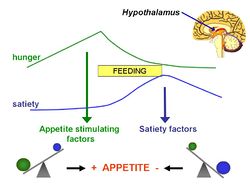Normal weight obesity: Difference between revisions
Jump to navigation
Jump to search

imported>Sawdah Jakda No edit summary |
imported>Sawdah Jakda No edit summary |
||
| Line 3: | Line 3: | ||
{{Image|Appetite.jpg|right|250px}} | {{Image|Appetite.jpg|right|250px}} | ||
The prevalence of obesity has risen rapidly over the years and shows no clear signs of slowing down. A great epidemiological representation of that can be seen in studies using the population of the US of A, collected from the 1960s to present time. It has shown that obesity in the population has increased from ~13% to almost 30%.<ref>Romero-Corral A ''et al.'' (2010) Normal weight obesity: a risk factor for cardiometabolic dysregulation and cardiovascular mortality'' Eur Heart J'' 31:737-46 PMID 19933515</ref> | |||
To clinically classify a person as being obese, their Body Mass Index (BMI) must be equal to or greater than 30kg/m2. However, the spectrum of obesity is quite large with Normal Weight Obesity (NWO) being at one end. NWO, found in almost half of the American adult population, is when a person has a normal BMI or normal body weight but also has a high percentage of body [[adipocyte|fat]](>20% for men and >30% for women) as well as heart and metabolic disturbances. <ref>Romero-Corral A ''et al.'' (2010) Normal weight obesity: a risk factor for cardiometabolic dysregulation and cardiovascular mortality'' Eur Heart J'' 31:737-46 PMID 19933515</ref> [[User:Sawdah Jakda|Sawdah Jakda]] 15:16, 25 October 2011 (UTC) | |||
== '''Measuring normal weight obesity''' == | == '''Measuring normal weight obesity''' == | ||
Revision as of 09:19, 25 October 2011
For the course duration, the article is closed to outside editing. Of course you can always leave comments on the discussion page. The anticipated date of course completion is 01 April 2012. One month after that date at the latest, this notice shall be removed. Besides, many other Citizendium articles welcome your collaboration! |
The prevalence of obesity has risen rapidly over the years and shows no clear signs of slowing down. A great epidemiological representation of that can be seen in studies using the population of the US of A, collected from the 1960s to present time. It has shown that obesity in the population has increased from ~13% to almost 30%.[1]
To clinically classify a person as being obese, their Body Mass Index (BMI) must be equal to or greater than 30kg/m2. However, the spectrum of obesity is quite large with Normal Weight Obesity (NWO) being at one end. NWO, found in almost half of the American adult population, is when a person has a normal BMI or normal body weight but also has a high percentage of body fat(>20% for men and >30% for women) as well as heart and metabolic disturbances. [2] Sawdah Jakda 15:16, 25 October 2011 (UTC)
Measuring normal weight obesity
Genetic links
Disorders linked to NWO
Treatments and Prevention
Conclusion
References
- ↑ Romero-Corral A et al. (2010) Normal weight obesity: a risk factor for cardiometabolic dysregulation and cardiovascular mortality Eur Heart J 31:737-46 PMID 19933515
- ↑ Romero-Corral A et al. (2010) Normal weight obesity: a risk factor for cardiometabolic dysregulation and cardiovascular mortality Eur Heart J 31:737-46 PMID 19933515
